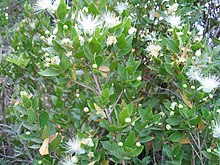Myrtaceae
| Myrtle familia Temporal range: Amay na Miocene-Presente, 22–0 Ma
PreЄ
Є
O
S
D
C
P
T
J
K
Pg
N
| |
|---|---|

| |
| Myrtus communis mga dahon asin burak | |
| Sayantipiko na klasipikasyon | |
| Kahadean: | Plantae |
| Klado: | Angiosperms |
| Klado: | Eudicots |
| Klado: | Core eudicots |
| Klado: | Rosids |
| Orden: | Myrtales |
| Pamilya: | Myrtaceae Juss.[1] |
| Genera | |
|
Igwang 130; Hilingon an listahan | |
Myrtaceae o ang myrtle familia sarong pamilya kang dicotyledonous na mga tanom yaun sa laog kan order Myrtales. Myrtle, pohutukawa, bay rum tree, clove, bayawas, acca (feijoa), allspice, asin eucalyptus an iba sa mga bistong espesye kaini. Gabos na espesye malakahoy, na igwang mga essential oil, asin igwang parte kan burak sa grupong apat o lima. An mga dahon gabos berde. An mga burak igwang limang petal. Asin an mga stamen sanga-sanga, makukulay asin kadakol.
Dibersidad
[baguhon | baguhon an source]An mga pinakabagong estima nagsasabi na an Myrtaceae igwa nin halos 5,950 na espesye sa laog kan 132 genera.[2][3]An pamilya igwa nin malawak na distribusyon sa tropikal asin maiinit na temperaturang mga rehiyon sa kinaban. An genera na may maga capsular na prutas arog kan Eucalyptus, Corymbia, Angophora, Leptospermum, asin Melaleuca mayo sa Amerika bukod sa Metrosideros as Chile asin Argentina. An genera na may malalaman na prutas madalas na mahihiling sa Sirangang Australia asin Malesia (anAustralasia ecozone) asin sa Neotropiko. An Eucalyptus dominante, o halos genus na yaun sa gabos na parte kan Australia asin nagaabot sa Pilipinas. An Eucalyptus regnans an pinakahalangkaw na tinanom na nagbuburak sa buong kinaban.iAn ibang importanteng Australian genera iyo an Callistemon (bottlebrushes), Syzygium, asin Melaleuca (ginagamit sa papel). An mga espesye kan genus Osbornia, natural sa Australasia, iyo an mga mangrove. Eugenia, Myrcia, asin Calyptranthes kasali sa dakulang genera sa neotropiko.
Mga ladawan
[baguhon | baguhon an source]-
Pimenta dioica
-
Syzygium samarangense,
Klasipikasyon
[baguhon | baguhon an source]Hali sa Wilson (2011)[4]
Subfamilia Psiloxyloideae
- tribo Psiloxyleae
- tribo Heteropyxideae
Subfamilia Myrtoideae
- tribo Xanthostemoneae
- tribo Lophostemoneae
- tribo Osbornieae
- tribo Melaleuceae
- tribo Kanieae
- tribo Backhousieae
- tribo Metrosidereae
- tribo Tristanieae
- tribo Syzygieae
- tribo Myrteae
- tribo Eucalypteae
- tribo Syncarpieae
- tribo Lindsayomyrteae
- tribo Leptospermeae
- tribo Chamelaucieae
Genera
[baguhon | baguhon an source]- Abbevillea
- Acca
- Accara
- Acmena
- Acmenosperma
- Actinodium
- Agonis
- Algrizea
- Allosyncarpia
- Amomyrtella
- Amomyrtus
- Angasomyrtus
- Angophora
- Archirhodomyrtus
- Arillastrum
- Astartea
- Asteromyrtus
- Austromyrtus
- Babingtonia
- Backhousia
- Baeckea
- Balaustion
- Barongia
- Basisperma
- Beaufortia
- Blepharocalyx
- Callistemon
- Calothamnus
- Calycolpus
- Calycorectes
- Calyptranthes
- Calyptrogenia
- Calythropsis
- Calytrix
- Campomanesia
- Chamelaucium
- Chamguava
- Cheyniana
- Choricarpia
- Cleistocalyx
- Cloezia
- Conothamnus
- Corymbia
- Corynanthera
- Cupheanthus
- Curitiba
- Cyathostemon
- Darwinia
- Decaspermum
- Enekbatus
- Eremaea
- Ericomyrtus
- Eucalyptopsis
- Eucalyptus
- Eugenia
- Gomidesia
- Gossia
- Harmogia
- Hexachlamys
- Homalocalyx
- Homalospermum
- Homoranthus
- Hottea
- Hypocalymma
- Kanakomyrtus
- Kania
- Kardomia
- Kjellbergiodendron
- Kunzea
- Lamarchea
- Legrandia
- Lenwebbia
- Leptospermum
- Lindsayomyrtus
- Lithomyrtus
- Lophomyrtus
- Lophostemon
- Luma
- Lysicarpus
- Malleostemon
- Marlierea
- Melaleuca
- Meteoromyrtus
- Metrosideros
- Micromyrtus
- Mitranthes
- Mitrantia
- Monimiastrum
- Mosiera
- Myrceugenia
- Myrcia
- Myrcianthes
- Myrciaria
- Myrrhinium
- Myrtastrum
- Myrtella
- Myrteola
- Myrtus
- Neofabricia
- Neomitranthes
- Neomyrtus
- Ochrosperma
- Octamyrtus
- Osbornia
- Paragonis
- Paramyrciaria
- Pericalymma
- Phymatocarpus
- Pileanthus
- Pilidiostigma
- Piliocalyx
- Pimenta
- Pleurocalyptus
- Plinia
- Pseudanamomis
- Psidium
- Purpureostemon
- Regelia
- Rhodamnia
- Rhodomyrtus
- Rinzia
- Ristantia
- Sannantha
- Scholtzia
- Seorsus
- Siphoneugena
- Sphaerantia
- Stereocaryum
- Stockwellia
- Syncarpia
- Syzygium
- Taxandria
- Thaleropia
- Thryptomene
- Tristania
- Tristaniopsis
- Ugni
- Uromyrtus
- Verticordia
- Waterhousea
- Welchiodendron
- Whiteodendron
- Xanthomyrtus
- Xanthostemon
Pagpadakol
[baguhon | baguhon an source]An Myrtaceae pinapalakop kan mga lukot, urog nang gayo an mga espesye kan Melipona bicolor na nagkukua nin pollen sa pamilya kan tinanom.[5]
Toltolan
[baguhon | baguhon an source]- ↑ Angiosperm Phylogeny Group (2009). "An update of the Angiosperm Phylogeny Group classification for the orders and families of flowering plants: APG III" (PDF). Botanical Journal of the Linnean Society 161 (2): 105–121. doi:. Archived from the original on 2017-05-25. https://wayback.archive-it.org/all/20170525104318/http://onlinelibrary.wiley.com/doi/10.1111/j.1095-8339.2009.00996.x/abstract. Retrieved on 2013-06-26.
- ↑ Christenhusz, M. J. M.; Byng, J. W. (2016). "The number of known plants species in the world and its annual increase". Phytotaxa (Magnolia Press) 261 (3): 201–217. doi:. http://biotaxa.org/Phytotaxa/article/download/phytotaxa.261.3.1/20598.
- ↑ Govaerts, R. et al. (12 additional authors). 2008. World Checklist of Myrtaceae. Royal Botanic Gardens, Kew. xv + 455 pp.
- ↑ Wilson, P. G. (2011) Myrtaceae. In The Families and Genera of Vascular Plants. Volume X. Sapindales, Cucurbitales, Myrtaceae, edited by K. Kubitzki, X:212–71. Heidelberg: Springer-Verlag, 2011.
- ↑ Hilário, S. D., and V. L. Imperatriz-Fonseca. "Pollen foraging in colonies of Melipona bicolor (Apidae, Meliponini): effects of season, colony size and queen number." Genetics and Molecular Research 8.2 (2009): 664-671.
Text is available under the CC BY-SA 4.0 license; additional terms may apply.
Images, videos and audio are available under their respective licenses.


